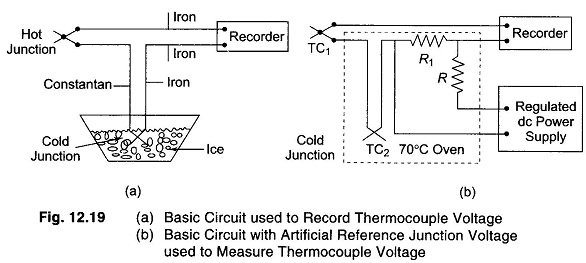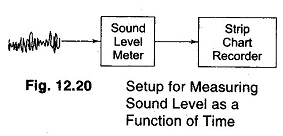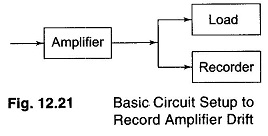Strip Chart Recorder Application:
The following are some of the thousands of Strip Chart Recorder Application for recorders in industry.
1. Temperature Recording:
A strip chart recorder may be used to provide a graphical record of temperature as a function of time. There are two primary methods used for recording temperature, the thermocouple method and the resistance method.
The thermocouple method utilizes commercially available thermocouples that cover a wide range of temperature. These serve very well as temperature-sensing elements and are readily compatible with strip-chart recorders.
The circuit shown in Fig. 12.19(a), is a basic circuit used to record the thermocouple voltage.
A thermocouple is made by joining two dissimilar metals. A potential difference, which is proportional to the temperature, exists across the junctions. This potential difference has an almost linear relationship with the temperature and is very repeatable.
Elaborate tables of temperature versus potential difference have been developed for certain pairs of metals that are used for commercial thermocouples. These tables allow one to determine the hot junction temperature when the cold junction or reference junction temperature is 0°C. If the reference temperature is not 0°C, correction factors may be used.
However, it is usually convenient to maintain the reference junction at 0°C or to develop an artificial reference junction emf by using a circuit as shown in Fig. 12.19(b).
Thermocouple TC2 is maintained at 70°C by the oven. The emf developed by TC2 is balanced out by the voltage drop across R, due to current flowing from the regulated dc power supply, until the total emf is equal to the emf of TC2 at 0°C.
(The two metals connected to the recorder terminal are of the same metal.)
2. Sound Level Recording:
In this Strip Chart Recorder Application, the frequently desirable to obtain a record of the sound level over a period of time, near highways, airports, hospitals, schools or residence.
This can be done with an ordinary microphone and a strip-chart recorder, provided the output signal from the microphone is of sufficient amplitude to drive the recorder.
A better setup for obtaining sound level data is to use a sound level meter and a strip chart recorder, as shown in Fig. 12.20.
3. Recording Amplifier Drift:
Transistor amplifiers are sensitive to temperature changes. Temperature changes causes the bias voltage of the transistor to change, thereby changing the operating or quiescent point, generally by a small amount. This change of the point is called Drift.
Since this is generally a slow process, a Strip Chart Recorder Application may be used to monitor and record the drift by connecting the recorder to the output of the amplifier, as shown in Fig. 12.21.


